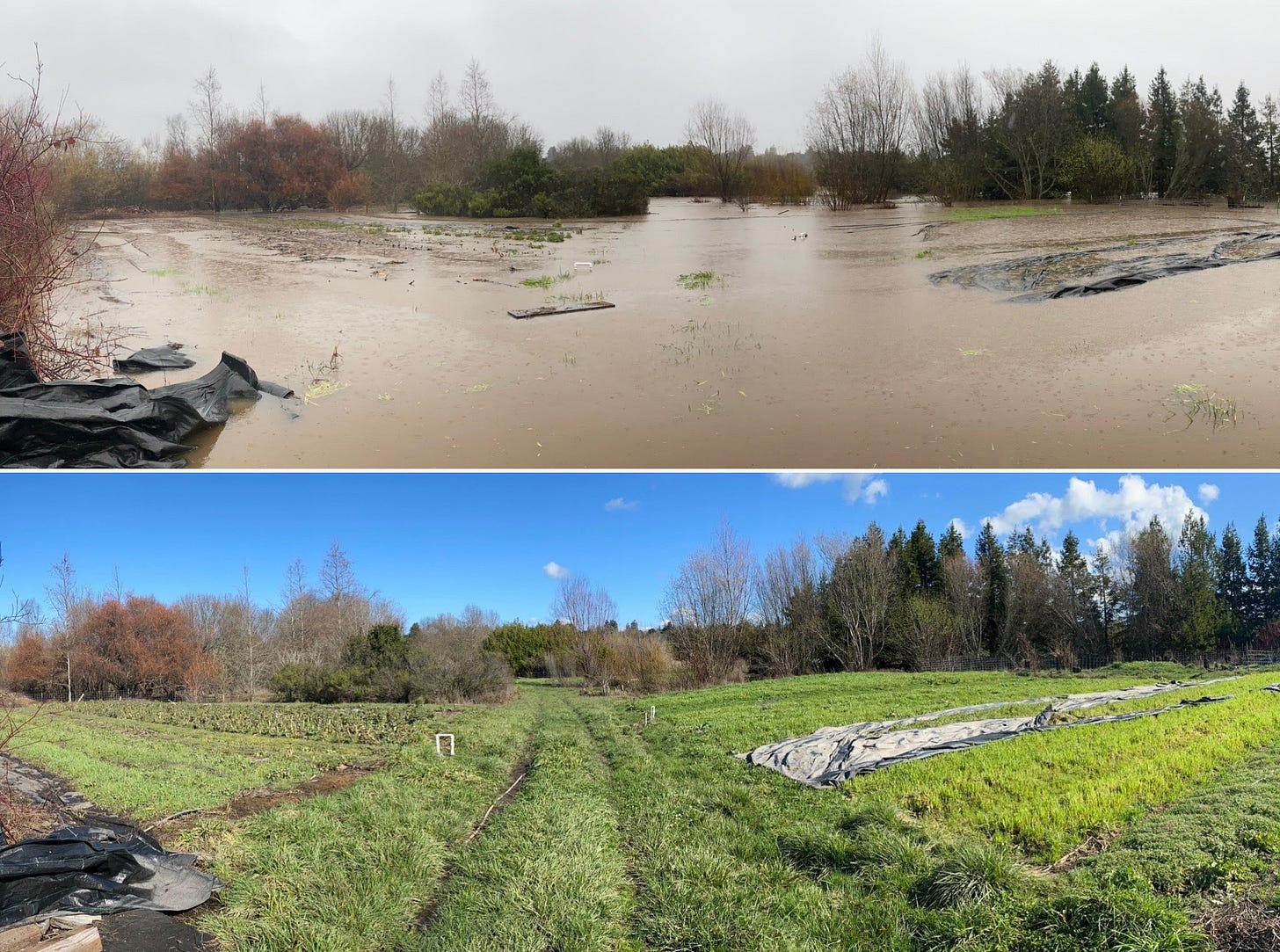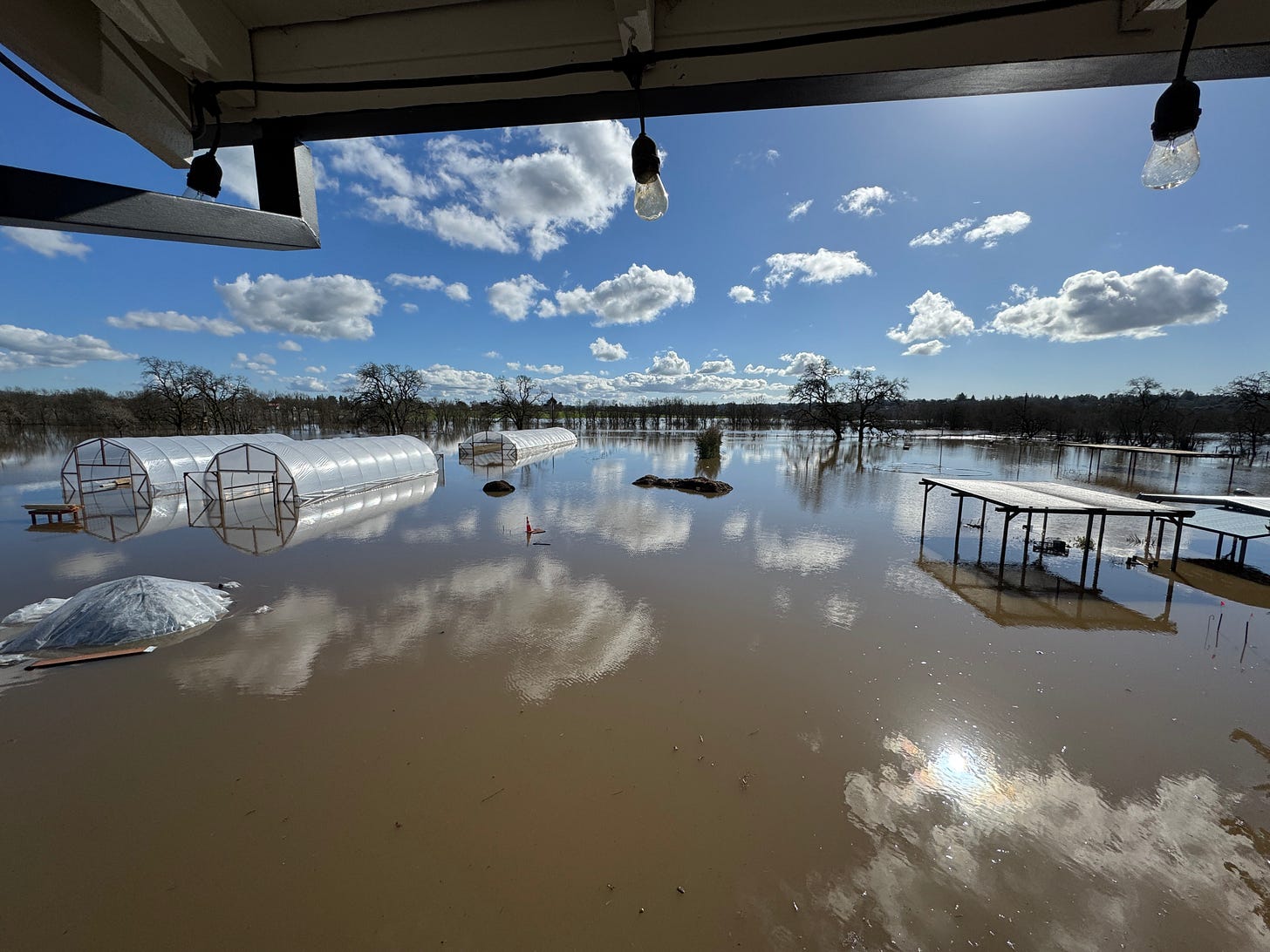Local farmers dig out after drenching rains
In West County, the rains giveth and the rains taketh away

Farmers depend on rain to help their crops grow, but a gusher of a storm like the one that came through this week can also create havoc.
This morning, in her newsletter for Singing Frogs Farm, just west of Sebastopol, farmer Elizabeth Kaiser, wrote the following:
Tuesday our bottom fields flooded, and by Wednesday morning it had all receded and we had sun. We got a good 4” of rain, and much of it within a couple hours Tuesday mid-day… that meant a huge river running onto our property, our drains at capacity, so overflowing dams, a sink hole as a result of gopher tunnels and, of course, we flooded to our high water mark. We lost one small crop of lettuce; we can’t harvest if flood water touches food crops.
We farm on the side of the Atascadero valley bottom, a flood plain. This is no surprise; this is Mother Nature’s way of slowing and sinking the water. It doesn’t work as well because instead of a meandering marshy area, the Army Corps of Engineers dug a channel which we now know as the Atascadero Creek and made most of this land passable and farmable. Atascadero is a Spanish word for wet muddy place and it used to be like a smaller Laguna de Santa Rosa.With the valley as it is, we’re ready for the flood every year, and most years we flood a little, but it’s not been to the high water mark in 2 years. We do not grow food crops in these fields in the winter for if flood water comes in the crops are no longer food safe. We instead plant cover crops in these beds. This year, thanks to a dedicated crew, we have more beds in cover crops and more kinds of cover crops than ever before. So if you look at the photos you’ll see green grass 6-18” tall and you may wonder where the fields are. This green grass is a mix of oats, rye, barley, peas, vetch, clovers, and more! These work to feed the soil through winter photosynthesis, but also hold the soil in place with their roots in these times of flood. The water recedes, and being good and healthy soil—with high soil organic matter that can hold spaces for air and infiltrate water—there is no damage. And so it looks as good as new (albeit a little muddy).
“We know that the bottom of our property floods,” Kaiser told the Sebastopol Times. “And the fact that some of our lettuce got hit—we were sort of gambling, sort of pushing right up against the edge of it. Basically, 20% of our fields, we can’t use in the winter, but we were trying to use as much of that as possible. And sometimes you fail and you lose a little bit.”
Kaiser estimated their loss at just $300.
Others weren’t so lucky.
Stephenie Chow runs a flower farm, Poppies and Petals, out on Stanford Road, which is smack in the middle of the Laguna de Santa Rosa floodplain. During the storm, her property—including hoop houses full of flowers—was inundated with three to four feet of water.

Chow, who said she’s normally shy about sharing personal struggles, posted pictures of her flooded farm on her Poppies and Petals Instagram account.
“Usually I don’t share my photos, but I was just devastated and really depressed, and I kind of just needed a little bit of positive support,” she said. “I usually only post positive things on Instagram, but I decided just to be real and show that farming isn't always skipping through the fields.”
She said the kind and generous responses she received to her Instagram post, “really got me through the last couple of days.”
Chow, who likes to accentuate the positive, says she hasn’t made it out to the largest hoop house yet—it was still too wet—but she was surprised and pleased to discover that some flowers elsewhere on the farm made it.
“In fact, this morning, I walked out where I could walk now, and I was going to post and have a positive note that so many things survived the flood. It’s heartwarming.”
Chow said she started her flower farm during COVID. “I think people just needed positiveness, and I think that’s what flowers really do.”
This is the second time in the last four months that Chow’s farm has flooded. The first time was during that massive storm in November. Chow said that these two flood events are unusual. It’s the first time this has happened in the four years they’ve lived here. They’ve owned the property for 25 years.
Because she still can’t reach much of her property, she doesn’t know yet how much has been lost.
“The last time this happened, the flowers were much smaller. There were a few varieties that didn’t make it, and we put in new ones. Unfortunately, it’s about the same timeframe, so I’m pretty sure I probably will have lost that crop again. But surprisingly, there are some flowers that are just invincible. Some make it, and some don’t.”
Back at Singing Farms, Elizabeth Kaiser blames climate change for the violence of recent storms.
“It’s been interesting this winter because the rainstorms have been so fast and furious,” Kaiser said. “That’s what they say about climate chaos is we’re going to have bigger, faster storms, but then less frequently and with bigger droughts—everything in extremes.”



Even though this news is not particularly good, with all the bad stuff in the news its a welcome diversion to read something like this - real people coping well with nature's vagaries.
As we learn our land and the people within we share it, we build a community. Singing Farm illustrates this concept. It is within our communities that we build the structure that sustains all of us...👍😉